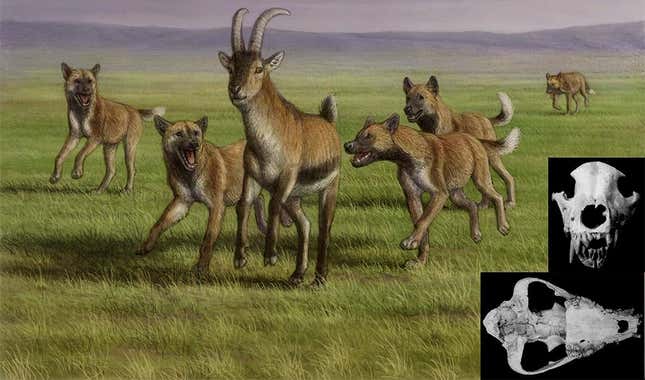
New research details the discovery of an extinct dog-like animal that lived in the Caucasus region of Europe some 1.7 million years ago. Intriguingly, early humans occupied the same region during this time, prompting questions about potential interactions.
The remains are scarce—a distinct jawbone fragment (with several teeth still attached) and a lower first molar—but it was enough evidence for Saverio Bartolini-Lucenti, a paleontologist at the University of Florence in Italy, and his colleagues to assign it as belonging to the species Canis (Xenocyon) lycaonoides. The two fragments, dated to between 1.77 million and 1.76 million years ago, were found near Dmanisi, Georgia, and they’re possibly the earliest evidence of “hunting dogs” in Europe.
My choice of scare quotes is deliberate, as these “hunting dogs” have basically nothing to do with domesticated dogs or even wolves for that matter. As Bartolini-Lucenti explained to me in an email, the use of “dogs” in this context is a metonymy, or a figure of speech, for describing canids in general, that is, members of the Canidae family. Also, scientists sometimes use the term “wild dogs” when describing hypercarnivorous canids like the Asian dhole (Cuon alpinus) or the African wild dog (Lycaon pictus), he said. By hypercarnivorous, Bartolini-Lucenti is referring to animals with diets consisting of at least 70% meat.
That said, Adam Hartstone-Rose, a professor of biological sciences at North Carolina State University and a paleontologist not associated with the new study, said the assigned name of the species, along with the term “dog,” are misleading, and possibly even inaccurate. The authors of the new paper would’ve been better off describing the specimen as belong to the Lycaon genus, as it’s a closer relation, he argues.

Analysis of the lone tooth showed very little wear and tear, suggesting a young but large adult. The studied specimen weighed about 66 pounds (30 kg), which is about the size of a modern gray wolf. The big and sharp tooth found in the middle of the jaw was likely used for shredding meat, and it compares to teeth found in other canids from the same era.
Bartolini-Lucenti, along with co-author Bienvenido Martinez-Navarro from the Universitat Rovira i Virgili in Spain, speculate that Canis (Xenocyon) lycaonoides could be an ancestor species to African wild dogs living today and that it originated in eastern Asia. The new paper now appears in Scientific Reports.
The animal featured a shortened face—a feature shared with both extinct and modern wild dogs and “connected to the strength of the bite and the hypercarnivorous diet,” wrote Martinez-Navarro. If this creature was like other wild dogs, it likely had elongated legs well suited for tracking down prey.
It’s a neat find, but it’s the location of this discovery that’s of particular interest to the researchers. The Caucuses is sometimes referred to as the “gateway of Europe,” as it intersects with both Africa and Asia. At the same time, fossil evidence from Georgia points to the presence of early humans (probably Homo erectus) approximately 1.8 million years ago, which roughly coincides with the age of the new fossil.
“Dmanisi is an amazing place—basically a little piece of African ecology” that essentially “looks like East and South Africa in terms of its animals and environmental reconstruction,” said Hartstone-Rose. It’s also at a “geographic and temporal crossroad of the Old World,” so “describing a fantastic carnivore to go along with the amazing hominins from there is exciting,” he said.
Not only that, “hunting dogs are one of the most interesting modern dog species—the most hypercarnivorous, the best runners (they have anatomical adaptations for distance running that exceed any found in other dog species), and they occupy an interesting ecological niche near the top of the African [food web] along with lions, leopards, and hyenas,” wrote Hartstone-Rose. “While we know all of this about this amazing animal, their fossil record is convoluted and confusing. The authors of this paper are among the leaders that have, for decades, been trying to sort this mess out.”
Interestingly, as early humans were migrating from Africa into Europe and Asia, these wild dogs were making the same trek, though in the opposite direction. The social, cooperative, and altruistic nature of both humans and canids, the study authors argue, likely made these journeys possible. Martinez-Navarro said it’s “fascinating to see how successful organisms” like early hominins and these wild dogs, “relied on other pack-member to survive, and how this behaviour helped them disperse from their centers of origin.”
Jaakko Pohjoismäki, a biologist from the University of Eastern Finland who wasn’t involved in the new study, thought it important to point out that the researchers, when referring to altruism, “mean mutual aid between the members of the group, not between groups or species.”
Although not discussed by the researchers, Pohjoismäki said it’s “tempting to speculate that this convergent social behaviour might be the basis for human-domestic dog cooperation as well.” Modern domesticated dogs are descended from Eurasian wolves—another social animal—and “they are not related to the species group discussed in the paper, apart from being canids,” he wrote in an email.
Early humans and wild dogs may have lived in the same vicinity during this time period, but as Hartstone-Rose pointed out, that doesn’t mean the dogs lived with humans.
“Think of it this way, if I am buried here in North Carolina, my bones might be found along with those of black bears and bobcats, even though I may never have even seen these animals near my home,” he explained. “Living alongside an animal does not necessarily imply interaction.”
Indeed, it seems unlikely that these two species cooperated with each other, and it seems more likely that humans were prey to these wolf-like hypercarnivores. Regardless, the new paper presents some interesting food for thought, and the fascinating possibility that early humans gazed upon dog-like creatures well over a million years before the rise of domesticated dogs.
More: Too much meat during ice age winters gave rise to dogs.